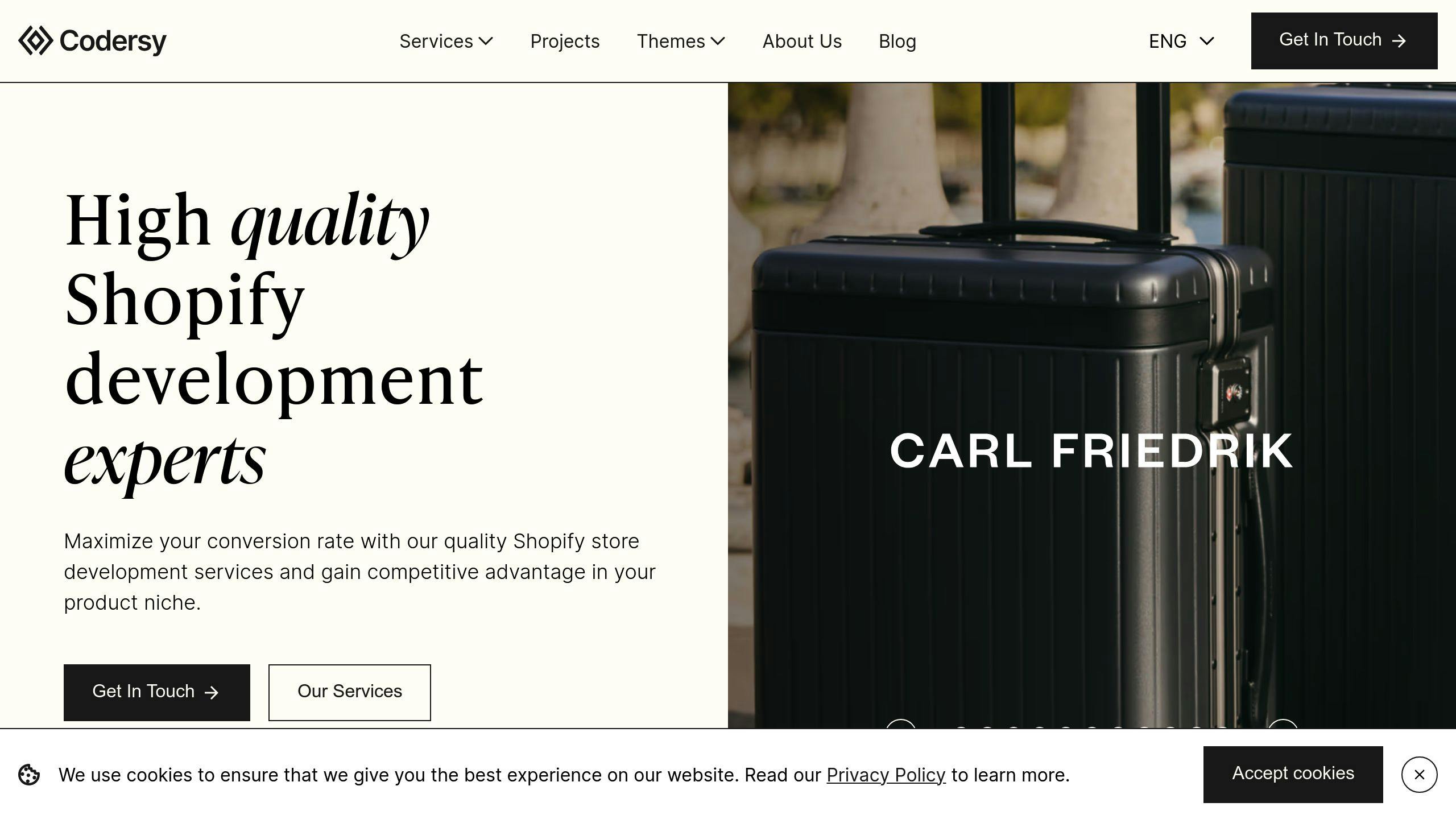By Mladen Terzic
Shopify Architecture & Infrastructure
25th May 2025
9 min read
Shopify 2.0 Features for Migrated Custom Themes
Discover the key Shopify 2.0 upgrades—faster load times, JSON-based layouts, and app blocks—that make migrating custom themes worthwhile. Learn migration tips, compatibility checks, and when to bring in experts.

Shopify 2.0 simplifies online store management with faster loading speeds, easier customization, and seamless app integration. Key features include:
- Enhanced Performance: Faster page load times with optimized code and resource management.
- Flexible Customization: JSON templates allow unique layouts for every page without coding.
- App Blocks: Easily integrate apps directly into themes for better design and functionality.
Migrating Tips:
- Use Shopify's Dawn theme for a quick start.
- Update existing themes manually or work with developers for complex setups.
- Test thoroughly for compatibility and performance improvements.
Switching to Shopify 2.0 ensures a smoother, faster, and more user-friendly store experience.
How to Migrate Shopify Themes to Online Store 2.0

Shopify 2.0 Features That Improve Custom Themes
Shopify 2.0 brings a new level of functionality to custom themes, making it easier for merchants to manage and enhance their online stores.
Faster Page Speed and Performance
Shopify 2.0's updated architecture focuses on improving how quickly pages load and perform. Here's a breakdown of some key features:
| Feature | Benefit |
|---|---|
| Optimized Code Structure | Cleaner code leads to quicker page rendering |
| Resource Management | Streamlined asset delivery reduces load times |
| Modern JavaScript | Better client-side performance and responsiveness |
These updates ensure custom themes run smoothly and provide a better experience for users, no matter the device.
Easier Page Customization with Sections
With Shopify 2.0, merchants can now use JSON templates to create different layouts for various content types - all without needing to code. This feature removes the limitations of static page layouts, giving store owners more control over their site's look and feel.
This flexibility makes it much simpler to update and manage store content, letting merchants focus on what matters most: their business.
Smarter App Integration with App Blocks
App blocks change the game for integrating third-party apps into custom themes. They make it easy to add dynamic features while keeping the design consistent.
Here’s what makes app blocks stand out:
- No coding required for app integration
- Themes stay fast and stable
- Content can be positioned flexibly within layouts
- Updates are easier with Theme API and Assets API
This system ensures apps and themes work together seamlessly [2], making custom themes easier to manage while maintaining top performance.
How to Migrate Custom Themes to Shopify 2.0
Using a Shopify 2.0-Compatible Theme
Shopify's Dawn theme is a great starting point for migration. It's 35% faster than the older Debut theme and gives you full access to Shopify 2.0 features without much technical hassle.
When choosing a theme, keep these factors in mind:
| Migration Factor | What to Look For |
|---|---|
| Speed Performance | Themes optimized for faster loading |
| Feature Compatibility | Access to sections and app blocks |
| Development Time | Less time spent on setup and adjustments |
| Customization Level | Options to tweak the design to fit your brand |
Manually Updating Code for Migration
If your store has unique needs, manual updates might be the way to go. This involves converting Liquid templates into JSON files, enabling sections across your site, and updating settings to support app blocks [2]. While this method demands advanced coding skills, it allows you to retain and customize unique features for your store.
Upgrading Existing Custom Themes
If you're using a custom theme, check if the developer offers a Shopify 2.0-compatible version. This lets you keep your customizations while gaining access to new features.
App blocks make app integration easier, allowing for simple customization and uninstalls. Tools like Shopify CLI and Theme Check can help you upgrade your theme and ensure everything works smoothly.
For complex custom themes, consider hiring experts. Shopify Plus development agencies specialize in handling technical migrations, preserving your brand's unique design, and ensuring your store performs at its best.
No matter which method you choose, thorough planning and checking for compatibility are key to a smooth migration.
sbb-itb-6dc743d
Tips for a Smooth Migration to Shopify 2.0
Upgrading your theme is just the first step. To ensure your migration goes off without a hitch, you'll need a well-thought-out plan and thorough testing.
Check Theme and App Compatibility
Before diving into the migration, take a close look at your current theme setup and app integrations. Shopify's Theme API and Assets API can help with this process [1]. Here's a quick checklist to guide you:
- Theme Architecture: Confirm that your theme uses JSON templates for section-based customization.
- App Integrations: Ensure your apps support app blocks to avoid losing functionality.
- Custom Code: Check that any Liquid templates in use will transition smoothly.
- Store Performance: Measure your store's current speed to track changes after migration.
Testing early is key. Use tools like Shopify CLI and Theme Check to catch potential issues without affecting your live store [2].
Plan for Development and Customization
A solid technical plan is the backbone of a successful migration. Start by documenting all current theme customizations and setting a clear timeline. Keep these factors in mind:
| Development Aspect | Key Consideration |
|---|---|
| Technical Complexity | Identify any custom features you’ll need. |
| Resource Allocation | Plan for time and budget constraints. |
| Performance Goals | Define measurable speed and functionality targets. |
| Testing Protocol | Schedule rigorous testing for quality assurance. |
For more complex migrations, it’s worth bringing in expert developers. Shopify Plus specialists can handle migrations while maintaining your store's custom features and performance [1]. To minimize disruptions, aim to migrate during off-peak hours.
If your store requires advanced customizations or technical expertise, professional help can make the transition much smoother.
Professional Help for Custom Theme Migration
Migrating complex custom themes to Shopify 2.0 can be a challenging process. Professional help can make it much easier, ensuring the job is done right. Agencies like Codersy specialize in handling these migrations, offering the expertise needed to tackle the complexities effectively.
Codersy: Shopify 2.0 Migration Services

Codersy provides migration services tailored specifically for Shopify 2.0. They focus on integrating features like sections everywhere and app blocks while enhancing your store's design and functionality. Their process ensures that custom functionalities are preserved while taking full advantage of Shopify 2.0's tools.
| Service Component | Migration Benefits |
|---|---|
| Custom Theme Development | Ensures compatibility with sections everywhere and JSON templates |
| Technical SEO | Protects your search engine rankings during and after the migration process |
| Performance Optimization | Boosts page speed by utilizing Shopify 2.0's updated architecture |
Their professional services include a complete evaluation, strategic planning, and careful implementation to make your store fully compatible with Shopify 2.0. Developers use Shopify's latest tools to carry out migrations while ensuring your store's functionality remains intact.
When hiring professionals, look for experienced Shopify Plus developers with a solid track record, deep technical skills, and strong project management capabilities.
Conclusion: Making the Most of Shopify 2.0
Shopify 2.0 introduces a game-changing framework for custom theme development, offering faster load times, flexible customization options, and easy app integration. These updates enhance both the shopping experience and store performance, making the switch a smart choice for businesses aiming to grow.
With the right strategy and expert support, businesses can take full advantage of these updates to build a smooth and efficient online store. The platform's updates redefine how merchants manage and expand their digital storefronts.
"Online Store 2.0 marks an end-to-end overhaul of how themes are built at Shopify, with sections on every page and app-powered blocks simplifying customization." - Shopify Partners Blog [2]
A successful migration to Shopify 2.0 hinges on careful preparation. Store owners should prioritize the following key elements:
| Key Area | Benefit to Store Performance |
|---|---|
| Theme Structure | Faster load times and better mobile performance |
| App Integration | Simplified app management |
| Content Tools | Flexible customization using dynamic metafields |
For those planning the move, working with experienced developers can ensure the process aligns with business objectives. Upgrading to Shopify 2.0 can lead to better performance, improved user experiences, and greater customization options.
As Shopify evolves, keeping up with these updates gives online stores a competitive edge. By using Shopify 2.0's advanced tools, businesses can set themselves up for long-term growth in the ever-changing e-commerce world.


